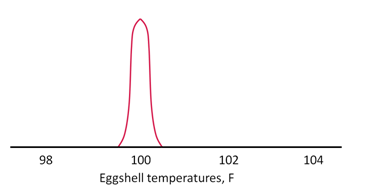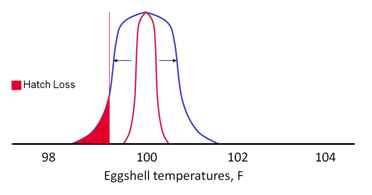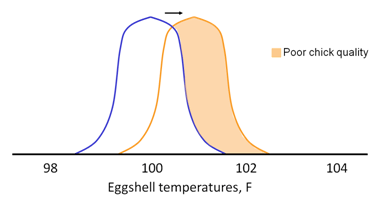The hatch window is considered a management tool in modern commercial hatcheries. This paper will discuss the definition of the hatch window and why it is considered important to manage. The embryo and incubation equipment factors that influence the hatch window will be discussed. The impact of methods to shorten the hatch window will be discussed. This paper will also discuss the impact of incubation during the hatch window on chick quality.
Definition of hatch window
What is the "natural" hatch window for a set of eggs? The definition of "natural" hatch window is the time that it takes the chicks to hatch in an ideal incubation environment. In other words, there is no equipment influence on the hatch window. Only in this "natural" situation can the hatch window be defined only from the embryo perspective. In reality, a natural hatch window can only occur when the hen sets and hatches the eggs. In any commercial incubation situation, the hatch window is influenced by the equipment design, operation and profile. All commercial incubation is the result of the embryo and machine interaction. The interpretation of the hatch window, long or short, is only relevant as it relates to the requirements of the production hatchery, the embryos, and the chicks.
Impact of genetic selection and incubation on the hatch window
Today all commercial chicks and eggs are produced from parents that have been genetically selected. Genetic selection for breast meat yield or egg production influences not only the chick but also the egg quality and the embryo. How does this influence what the embryo needs for successful incubation and hatch? Genetic selection has:
1. Altered the heat production of the embryo. As embryo heat production increases, embryo temperature increases (in the same environment).
2. Selected for more altricial birds. Altricial birds have a higher growth rate but are less mature at hatch.
3. Decreased conductance of the egg shell. Conductance of the eggshell influences the total incubation time.
Characteristics of the egg and the embryo that impact the hatch window are:
1. Conductance of the egg shell
2. Genetic line
3. Embryo heat production
4. Egg size
5. Egg selection
6. Sex: Male or female
7. Egg storage time
8. Breeder flock age
While all of these factors influence the hatch window, they are only important in mixed sets of eggs. If the egg sets are not mixed, these factors (especially conductance) determine the normal curve of the hatch window. In commercial incubation, the machine design, operation, and profile has more impact on hatch window than the egg characteristics.
Machine design, operation, and profiles
Uniformity of the egg mass is the key to:
1. Natural hatch window
2. Maximum hatchability
3. Optimum chick quality
The machine design, operation, and profiles create the uniformity of incubation conditions within the egg mass. Relative humidity, air temperature, and airflow create the environment within the egg mass and "create" the hatch window.
Procedures to shorten (or manage) the hatch window
There are many different procedures in practice today that are designed to shorten the hatch window, many are actually detrimental to chick quality. They do not solve the underlying issue, but they can shorten the hatch window.
Both high and low embryo temperatures create long hatch windows and chick quality problems. Low embryo temperatures create hatch loss. Most procedures are designed to stimulate the embryos that have been in the cold areas of the incubator or hatcher to hatch. Many of these procedures are incorrectly considered to be requirements of the embryo when in fact, they are done to correct for deficiencies in equipment design.
1. Transfer patterns: Transfer patterns that move embryos from specific locations in the setter to specific locations in the hatcher are simply moving eggs from the cold areas (cold embryo temperature) in the setter to the hot areas (high embryo temperature) in the hatcher. This improves the hatch window, but it cannot improve chick quality.
2. Monitoring the hatcher and signs of hatch to change hatcher conditions: This is often done two ways:
a. Increase hatcher temperature: This increases embryo temperatures but decreases chick quality.
b. Increase carbon dioxide levels: Higher carbon dioxide levels are often used to "stimulate" the chicks to hatch. In reality, high carbon dioxide levels decrease ventilation. Since most machines use ventilation for cooling, this has the impact of increasing the embryo temperature and therefore "stimulating" chicks to hatch.
3.Circadian incubation: Circadian incubation programs periodically increase the air temperature and therefore the embryo temperature. This increases the metabolism of the embryo. Embryo development accelerates and consequently the chicks will hatch earlier. Embryos that were incubated in cold areas in the incubator will hatch on time instead of too late for normal chick harvest time.
4. Moving trolleys inside the incubator during incubation: Embryos are moved between relatively warm and cool areas to equalize hatch time. While this system will shorten the hatch window and somewhat improve chick quality, it is not necessary if the egg mass/embryo temperatures are uniform.
Why is a short hatch window desirable? Or is it?
Chicks that are comfortable (rectal temperature 40-40.6ºC, 104-105ºF) lose 1-2 grams of moisture per 24 hours. Chicks that are overheated (rectal temperature over 106ºF, 41.1ºC) lose 5-10 grams of moisture per 24 hours. If time after hatch was the only reason that chicks lose moisture, then it would not be possible to transport chicks. But it is possible to transport chicks as long as they are in their thermal comfort zone. The same is true of the time after hatch in the hatcher. If chicks are in their thermal comfort zone in the hatcher, they are not dehydrated. If they are above their thermal comfort zone (hot), then they are quickly dehydrated and it is necessary to monitor hatch window and pull immediately after hatch.
The one valid reason (that is not related to machine design) to monitor the hatch window is to get chicks to eat as soon as possible. Intestinal development begins 24 hours after the chicks first consume feed. Early feed consumption is correlated with good intestinal development and field performance.
The following graphs illustrates the interaction of environmental uniformity, air temperature on hatchability, hatch window and chick quality.
Figure I. Uniform Airflow: All Embryos 100ºF Optimum Hatch; Optimum Chick Quality, Natural Hatch Window
Figure II. Variation in Airflow : Variable Embryo Temperatures: Variable Chick Quality and Longer Hatch Window
Figure III. Variation in Airflow: Low Embryo Temperatures Result in Hatch and Chick Quality Loss, and Longer Hatch Window
Figure IV. Variation in Airflow: Increase Air Temperature Increases Embryo Temperature, Improves Hatch, Decreases Hatch Window BUT Decreases Chick Quality



















